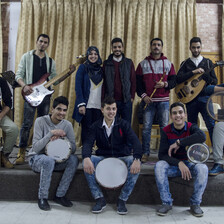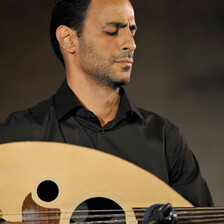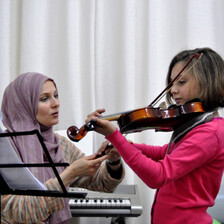Newsday 16 October 2002

Najeeb Shaheen in NY, September 2002. Photo by Nigel Parry.
The walls of his tiny West Village apartment are decorated with examples of the pudgy, lute-like string instrument. Still other ouds sit on chairs. And, his bedspread is embroidered with its likeness.
A Palestinian emigre, Shaheen builds, repairs and plays the oud in two bands. Interestingly, he learned his craftsman’s skills from a one-time Israeli citizen who now builds violins for a living in Manhattan.
“I think the oud [pronounced ‘ood,’] which is in the acoustic family, is probably the most perfect instrument,” said Shaheen, 55, easing back in a pink chair. The instrument is popular in northern Africa, southwest Asia and across the Mideast. “It’s earthy, it’s the closest to nature.”
Shaheen’s affection for the oud may lie in his DNA. He is part of a family of Arab Christian musicians who have played the string instrument for generations. Shaheen’s father was a professor of music and a master oud player, and his grandfather was a musician and a church cantor. His brother, Simon Shaheen, is known as one of the oud’s most accomplished adherents.
The oud has been around for centuries and is the forbearer of the European lute. Its name derives from the Arabic word for wood and refers to the strips used to make its pear-shaped body. The front of the oud is flat and the neck is short, with no frets.
“I don’t even know when I played the oud for the first time,” Shaheen said. “I must have been 5. By the time I was 15, I was repairing them too because they were everywhere.”
Shaheen attended a high school near Haifa that had both Jewish and Arab students but taught only in Hebrew. In 1967, angered by Israel’s treatment of the Palestinians, he left the country and moved to the United States to attend college.
“I felt like a third-class citizen,” Shaheen said. “I was not allowed to speak my language there. It was not a good place.”
In 1990, he decided to find out how to build the instrument, which he had by then long played and repaired. Rather than turning to one of the thousands of Arab oud makers, he instead asked a longtime friend, David Segal, an Israeli with a violin store on West 68th Street in Manhattan, David Segal Violins Ltd.
Like Shaheen, Segal was from a musical family. His father was an instrument maker who emigrated from Latvia to Israel. Segal had studied violin-, viola- and cello-making in Italy and moved to New York City in 1974 to serve as an assistant to the famous violinmaker Fernando Sacconi.
“I just took my knowledge of instruments and taught Najeeb how to use some of the tools,” said Segal. “Pretty soon he had set himself up in my shop and there were ouds everywhere.”
Not surprisingly, the two craftsmen find themselves debating the situation in the Middle East, but it does not cause them to turn against each other.
“Sometimes we agree, sometimes we disagree. Most often we disagree,” said Segal. “But we are like brothers, bonded by music, and so it has become a joke as well. If I tell him to move from one seat to another, he will turn to me and say, ‘What? You stole my land and now you want my chair as well?’ “
Over the past decade, Shaheen has used the skills Segal taught him to alter the structure of the ouds he builds and has experimented with non-traditional woods as well to adjust the sound.
Shaheen now builds the instruments in his workshop on West 36th Street between Seventh and Eighth avenues, marketing his services word-of-mouth to fellow musicians and selling ouds for about $3,000 apiece. “David taught me precision and patience,” he said. “Most oud makers, they never produced the sound you wanted as a musician. Now I can do that.”
Besides being different in composition from traditional ouds, Shaheen’s ouds also have another unique feature: pictures. For the past decade, Shaheen has cut pictures out of magazines and pasted them inside the belly of each instrument that he builds or repairs, where they often go unnoticed by the owner.
Sometimes Shaheen’s choices are politically inspired. He recently sent off an oud with the image of the face of Condelezza Rice inside. He plastered a picture of Ariel Sharon into the oud of an unknowing Palestinian activist.
The majority of his creations, though, have pictures of Hollywood celebrities and pro-wrestling grapplers. His most recent creation included a photograph of Mel Gibson.
The choice of these images reflects Shaheen’s changing interests. These days, he said, he tries not to think too much about politics, preferring a focus on perfecting his oud-making acumen.
“I never stop learning - and even now I am only 70 percent there,” he said. “Perhaps, when I die, I will be 90 percent there.”
Copyright © 2002, Newsday, Inc.


